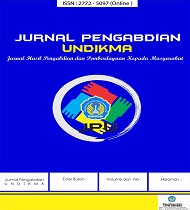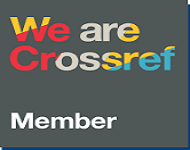Flipped Classroom : Model Pembelajaran untuk Mencapai Kecakapan Abad 21 Sesuai Kurikulum 2013
DOI:
https://doi.org/10.33394/jk.v7i2.3209Keywords:
Flipped Classroom, 21st-Century Learning, The 2013 Curriculum.Abstract
References
Abeysekera, L., & Dawson, P. (2015). Motivation and cognitive load in the flipped classroom: definition, rationale and a call for research. Higher Education Research and Development, 34(1), 1–14. https://doi.org/10.1080/07294360.2014.934336
Adhitiya, E. N. (2015). Studi Komparasi Model Pembelajaran Traditional Flipped Dengan Peer Instruction Flipped Terhadap Kemampuan Pemecahan Masalah. Unnes Journal of Mathematics Education., 4(2). https://doi.org/10.15294/ujme.v4i2.7451
Agustiningrum, A., & Haryono, A. (2017). Penerapan model pembelajaran flipped classroom dan course review horay berbasis lesson study untuk meningkatkan aktivitas dan hasil belajar siswa pada mata pelajaran ekonomi di kelas xi ips 2 man kota batu. 10(2), 111–120.
Akçayır, G., & Akçayır, M. (2018). The flipped classroom: A review of its advantages and challenges. Computers and Education, 126(August), 334–345. https://doi.org/10.1016/j.compedu.2018.07.021
Amiroh. (n.d.). Kenapa Harus Flipped Classroom? – Media Belajar IT Siswa dan Guru. Retrieved March 24, 2020, from http://amiroh.web.id/kenapa-harus-flipped-classroom/
Ariyanto, S. R., Lestari, I. W. P., Hasanah, S. U., Rahmah, L., & Purwanto, D. V. (2020). Problem Based Learning dan Argumentation Sebagai Solusi dalam Meningkatkan Kemampuan Berpikir Kritis Siswa SMK. Jurnal Kependidikan: Jurnal Hasil Penelitian Dan Kajian Kepustakaan Di Bidang Pendidikan, Pengajaran Dan Pembelajaran, 6(2), 197. https://doi.org/10.33394/jk.v6i2.2522
Asoodeh, M. H., Asoodeh, M. B., & Zarepour, M. (2012). The Impact of Student - Centered Learning on Academic Achievement and Social Skills. Procedia - Social and Behavioral Sciences, 46, 560–564. https://doi.org/10.1016/j.sbspro.2012.05.160
Awidi, I. T., & Paynter, M. (2019). The impact of a flipped classroom approach on student learning experience. Computers and Education, 128, 269–283. https://doi.org/10.1016/j.compedu.2018.09.013
Bergmann, J., & Sams, A. (2012). Flipped Classroom As Innovative Practice in the Higher Education System: Awareness and Attitude. In 3rd International Multidisciplinary Scientific Conference on Social Sciences and Arts SGEM 2016, Book 1 (Vol. 3, Issue SGEM2016 Conference Proceedings, ISBN 978-619-7105-72-8 / ISSN 2367-5659). https://doi.org/10.5593/sgemsocial2016/B13/S03.043
Billings, D. M. (2016). “Flipping†the Classroom. American Journal of Nursing, 116(9), 52–56. https://doi.org/10.1097/01.NAJ.0000494696.86240.35
Budiyono, B. (2020). Inovasi Pemanfaatan Teknologi Sebagai Media Pembelajaran di Era Revolusi 4.0. Jurnal Kependidikan: Jurnal Hasil Penelitian Dan Kajian Kepustakaan Di Bidang Pendidikan, Pengajaran Dan Pembelajaran, 6(2), 300. https://doi.org/10.33394/jk.v6i2.2475
Butt, A. (2014). Classroom Approach : Evidence From. Business Education, 6(1), 33–44.
Chiang, T. H. C. (2017). Analysis of learning behavior in a flipped programing classroom adopting problem-solving strategies. Interactive Learning Environments, 25(2), 189–202. https://doi.org/10.1080/10494820.2016.1276084
Dass, R. (2014). Literature and the 21st Century Learner. Procedia - Social and Behavioral Sciences, 123, 289–298. https://doi.org/10.1016/j.sbspro.2014.01.1426
Elmaadaway, M. A. N. (2018). The effects of a flipped classroom approach on class engagement and skill performance in a Blackboard course. British Journal of Educational Technology, 49(3), 479–491. https://doi.org/10.1111/bjet.12553
Foster, G., & Stagl, S. (2018). How effective is the Inverted Classroom Model ( ICM ), a teaching tool most SC. Journal of Cleaner Production. https://doi.org/10.1016/j.jclepro.2018.02.177
He, W., Holton, A., Farkas, G., & Warschauer, M. (2016). The effects of flipped instruction on out-of-class study time, exam performance, and student perceptions. Learning and Instruction, 45, 61–71. https://doi.org/10.1016/j.learninstruc.2016.07.001
Kong, S. C. (2014). Developing Information Literacy and Critical Thinking Skills through Domain Knowledge Learning in Digital Classrooms: An Experience of Practicing Flipped Classroom Strategy. Computers & Education. https://doi.org/10.1016/j.compedu.2014.05.009
Laar, E. Van, Deursen, A. J. A. M. Van, Dijk, J. A. G. M. Van, & Haan, J. De. (2017). The relation between 21st-century skills and digital skills or literacy: A systematic literature review. The Relation between 21st-Century Skills and Digital Skills or Literacy A Systematic Literature Review. https://doi.org/10.1016/j.chb.2017.03.010
Maolidah, I. S., Ruhimat, T., & Dewi, L. (2017). EFEKTIVITAS PENERAPAN MODEL PEMBELAJARAN FLIPPED. 3(2), 160–170.
Mastura, T., Soh, T., Mohamad, N., & Osman, K. (2010). The Relationship of 21 st Century Skills on Students ’ A ttitude and Perception towards Physics. 7(2), 546–554. https://doi.org/10.1016/j.sbspro.2010.10.073
Munir, M. T., Baroutian, S., Young, B. R., & Carter, S. (2018). Flipped classroom with cooperative learning as a cornerstone. Education for Chemical Engineers, 1–9. https://doi.org/10.1016/j.ece.2018.05.001
Nurpianti, S., Suwarma, I. R., & Jauhari, A. (n.d.). Kajian Implementasi Pendekatan Flipped Classroom pada Pembelajaran Fisika. 115–119.
O’Flaherty, J., & Phillips, C. (2015). The use of flipped classrooms in higher education: A scoping review. Internet and Higher Education, 25, 85–95. https://doi.org/10.1016/j.iheduc.2015.02.002
Ongardwanich, N., Kanjanawasee, S., & Tuipae, C. (2015). Development of 21 st Century Skill Scales as Perceived by Students. Procedia - Social and Behavioral Sciences, 191, 737–741. https://doi.org/10.1016/j.sbspro.2015.04.716
Ontario’s. (2015). Ontario ’ s Draft 21st Century / Global Competencies Achieving Excellence : A Renewed Vision for Education in 21st Century Competencies Discussion Document : What We ’ ve Learned. December, 53–56.
Qian, M., & Clark, K. R. (2016). Computers in Human Behavior Game-based Learning and 21st century skills : A review of recent research. Computers in Human Behavior, 63, 50–58. https://doi.org/10.1016/j.chb.2016.05.023
Rafianti, I., Anriani, N., & Iskandar, K. (2018). PENGEMBANGAN PERANGKAT PEMBELAJARAN MATEMATIKA. 3(1), 123–138.
Redhana, I. W. (2019). Mengembangkan Keterampilan Abad Ke-21 Dalam Pembelajaran Kimia. Jurnal Inovasi Pendidikan Kimia, 13(1).
Rindaningsih, I. (2018). Efektifitas Model Flipped Classroom dalam Mata Kuliah Perencanaan Pembelajaran Prodi S1 PGMI UMSIDA. Proceedings of the ICECRS, 1(3), 51–60. https://doi.org/10.21070/picecrs.v1i3.1380
Rindaningsih, I., Hastuti, W. D., & Findawati, Y. (2019). Desain Lingkungan Belajar yang menyenangkan berbasis Flipped Classroom di Sekolah Dasar. https://doi.org/10.21070/picecrs.v2i1.2452
Roehl, A., Reddy, S. L., & Shannon, G. J. (2013). The Flipped Classroom : An Opportunity Students Through Active. 105(2), 44–49.
Teo, P. (2019). Learning , Culture and Social Interaction Teaching for the 21st century : A case for dialogic pedagogy. 21(January), 170–178. https://doi.org/10.1016/j.lcsi.2019.03.009
Tim, K., & Widjajanti, C. (n.d.). Peningkatan Proses Pembelajaran Dan Penilaian Pembelajaran Abad 21 Dalam Meningkatkan Kualitas Pembelajaran SMK.
van Alten, D. C. D., Phielix, C., Janssen, J., & Kester, L. (2019). Effects of flipping the classroom on learning outcomes and satisfaction: A meta-analysis. Educational Research Review, 28(November 2018), 1–18. https://doi.org/10.1016/j.edurev.2019.05.003
Wijoyo, A. (2010). PENGARUH HASIL BELAJAR SISWA DENGAN MENGGUNAKAN MULTI MEDIA.
Wulansari, R., Rusnayati, H., Saepuzaman, D., And, S. K., & A, S. F. (2019). The influence of scientific creativity and critical worksheets ( SCCW ) on creative thinking skills and critical scientific as well as students ’ cognitive abilities on project-based learning work and energy concepts The influence of scientific creativity. https://doi.org/10.1088/1742-6596/1280/5/052039
Yamarik, S. (2019). Flipping the classroom and student learning outcomes: Evidence from an international economics course. International Review of Economics Education, 31(September 2018), 100163. https://doi.org/10.1016/j.iree.2019.100163
Yasin, R. N. T. F. (n.d.). Pemanfaatan Flipped Classroom Berbasis Rumah Belajar | Blog Rumah Belajar. Retrieved March 24, 2020, from http://pena.belajar.kemdikbud.go.id/2019/10/pemanfaatan-flipped-classroom-berbasis-rumah-belajar/
Downloads
Published
How to Cite
Issue
Section
Citation Check
License
License and Publishing Agreement
In submitting the manuscript to the journal, the authors certify that:
- They are authorized by their co-authors to enter into these arrangements.
- The work described has not been formally published before, except in the form of an abstract or as part of a published lecture, review, thesis, or overlay journal.
- That it is not under consideration for publication elsewhere,
- That its publication has been approved by all the author(s) and by the responsible authorities tacitly or explicitly of the institutes where the work has been carried out.
- They secure the right to reproduce any material that has already been published or copyrighted elsewhere.
- They agree to the following license and publishing agreement.
Copyright
Authors who publish with JK agree to the following terms:
- Authors retain copyright and grant the journal right of first publication with the work simultaneously licensed under a Creative Commons Attribution License (CC BY-SA 4.0) that allows others to share the work with an acknowledgment of the work's authorship and initial publication in this journal.
- Authors are able to enter into separate, additional contractual arrangements for the non-exclusive distribution of the journal's published version of the work (e.g., post it to an institutional repository or publish it in a book), with an acknowledgment of its initial publication in this journal.
- Authors are permitted and encouraged to post their work online (e.g., in institutional repositories or on their website) prior to and during the submission process, as it can lead to productive exchanges, as well as earlier and greater citation of published work.
Licensing for Data Publication
-
Open Data Commons Attribution License, http://www.opendatacommons.org/licenses/by/1.0/ (default)

This work is licensed under a Creative Commons Attribution-ShareAlike 4.0 International License.







